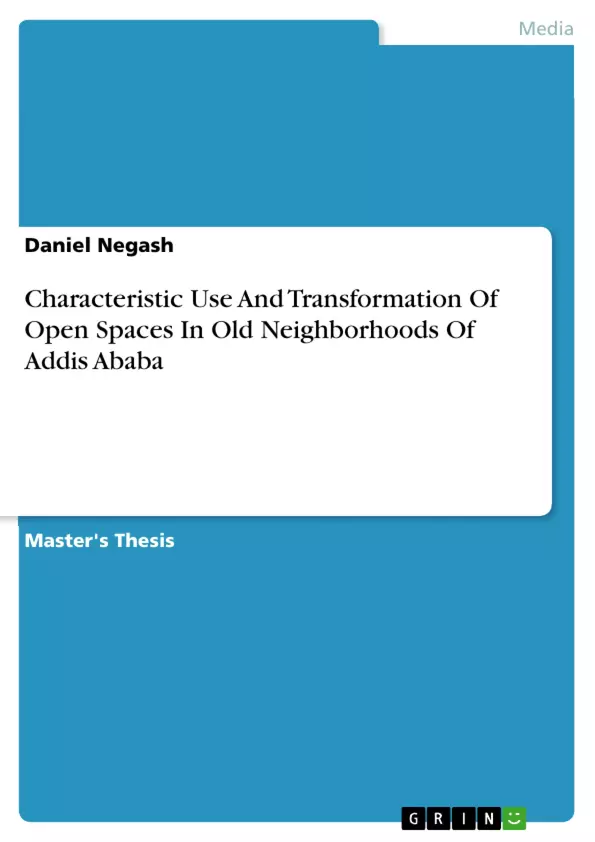The main objective of this research is to understand the age long experiences of people living around shared residential open spaces in the old neighborhoods of Addis Ababa. And the manner is focused on the comprehension of the shared open spaces in the neighborhoods as a social and cultural products or phenomena.
Case study research is employed to do this research because it is an auspicious method to study such contemporary phenomenological processes. Particularly four shared open spaces are systematically chosen from the inner-city old neighborhoods and studied. The research tries to understand the shared open spaces through their physical and spatial character: spatial configurations and transformations and their relationship with the dwellers; covering such aspects as: activities, meanings, behaviors, communications and perception. And both quantitative and qualitative data are collected through in-depth interviews, mapping, time diaries, observations and photography. The collected data is analyzed through comparative pattern matching, statistical computations, semantic differentials and cross-compound analysis.
The study revealed that the open spaces have from four up to five layers of spaces where different activities are entertained; which are executed out of sheer necessity, option, social and cultural interests. And the distinctions are marked by either physical elements (territorial markers) or expressed through routines. It also showed how well surveilled the open spaces are because of the overlap of activities and layering of spaces. However lack of systematic segregation and ordering of activities marred their effectiveness. In addition, it also showed that women and children are the predominant users of the open spaces whereas the adult males have different spatial predispositions.
Finally, the study has positively drawn lessons in such areas as, creation of layers of spaces that are often complimented by the layering of associations and the inoculation of security and the implication of gender, culture and socio economics on the use of space. Besides, it also highlighted the contribution of domestic open spaces, if organized well in space and time, in readily solving the shortage spaces at home and in bringing economic and cultural sustainability in low income communities.
Table of Contents
- Abstract
- Acknowledgments
- Chapter 1: Introduction
- 1.1 Background of the Study
- 1.2 Statement of the Problem
- 1.3 Objectives of the Study
- 1.3.1 General Objectives
- 1.3.2 Specific Objectives
- 1.4 Research Questions
- 1.5 Significance of the Study
- 1.6 Scope and Limitation of the Study
- 1.7 Organization of the Study
- Chapter 2: Literature Review
- 2.1 Understanding Open Spaces
- 2.2 Open Spaces in the Context of Addis Ababa
- 2.3 Conceptual Framework
- Chapter 3: Research Methodology
- 3.1 Research Approach
- 3.2 Study Area
- 3.3 Sampling Techniques
- 3.4 Data Collection Techniques
- 3.5 Data Analysis Techniques
- Chapter 4: Findings and Discussion
- 4.1 Socio-Demographic Profiles of the Dwellers
- 4.2 Spatial Configurations and Transformations of the Shared Open Spaces
- 4.3 Activities and Meanings Associated with the Shared Open Spaces
- 4.4 The Use of Shared Open Spaces by Gender and Age Groups
- 4.5 The Role of Shared Open Spaces in Bringing Economic and Cultural Sustainability
- Chapter 5: Conclusion and Recommendation
Objectives and Key Themes
This research aims to delve into the long-standing experiences of residents residing around shared residential open spaces in the historical neighborhoods of Addis Ababa. The study focuses on understanding these shared spaces as social and cultural products, exploring their evolution and impact on the communities they serve.
- The physical and spatial characteristics of shared open spaces in old Addis Ababa neighborhoods.
- The social and cultural significance of these open spaces for local residents.
- The impact of gender, age, and socioeconomic factors on the use and perception of shared open spaces.
- The potential of shared open spaces to contribute to economic and cultural sustainability in low-income communities.
- The role of open spaces in fostering a sense of community and social interaction.
Chapter Summaries
Chapter 1 introduces the research topic, outlining its background, objectives, and research questions. It establishes the significance of the study and delineates its scope and limitations. Chapter 2 reviews relevant literature concerning open spaces, with a focus on the context of Addis Ababa. It explores the conceptual framework guiding the research. Chapter 3 details the research methodology employed, encompassing the research approach, study area, sampling techniques, data collection methods, and data analysis techniques. Chapter 4 presents the findings and discussion, exploring the socio-demographic profiles of residents, the spatial configurations and transformations of shared open spaces, the activities and meanings associated with them, the use of spaces by gender and age groups, and the role of open spaces in fostering economic and cultural sustainability.
Keywords
This research centers on the themes of shared residential open spaces, their physical and spatial characteristics, and their social and cultural significance in the context of old neighborhoods in Addis Ababa. It explores the influence of gender, age, and socioeconomic factors on the use of these spaces, highlighting their potential for economic and cultural sustainability and community building.
- Quote paper
- Daniel Negash (Author), 2016, Characteristic Use And Transformation Of Open Spaces In Old Neighborhoods Of Addis Ababa, Munich, GRIN Verlag, https://www.grin.com/document/424084



